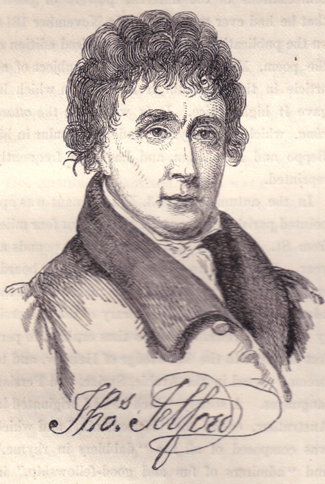|
TELFORD, or TELFER,
a surname from Taillefer, Iron cutter, borne by a Norman knight, who
landed with the Conqueror, and we are told, went before the army to the
attack of the Saxons, singing chivalrous songs, throwing his sword in
the air and catching it again as it fell.
TELFORD, THOMAS, a distinguished civil engineer, was born of
parents in humble life in the pastoral valley of Eskdale, in
Dumfries-shire, in 1757. He received a limited education at the parish
school of Westerkirk, but afterwards taught himself Latin, French,
Italian, and German. At the age of fourteen he was bound apprentice to a
builder in his native parish, where he for some years worked as a
stone-mason. After the expiry of his time he went to Edinburgh, where he
studied the principles of architecture. In 1782 he proceeded to London,
and obtained employment under Sir William Chambers, in the building of
Somerset House. Here his great merit became conspicuous, and he was
subsequently engaged in superintending some works belonging to
government in Portsmouth dock-yard. In 1787 he was appointed surveyor of
public works in the county of Salop, a situation which he held till his
death. In 1790 he was employed by the British Fishery Society to inspect
the harbours at their respective stations, and he devised the plan for
the extensive establishment at Wick, in the county of Caithness, which
is now known by the name of Pulteneytown. IN the years 1803 and 1804 the
parliamentary commissioners for making roads and building bridges in the
Highlands of Scotland, appointed him their engineer; and, under his
directions, eleven hundred bridges were built, and 860 miles of new road
constructed. The Caledonian canal was also completed according to his
plans. In these and various other works which he executed in different
districts in England, Scotland, and Wales, his extraordinary skill
enabled him to surmount difficulties of the greatest magnitude. The most
stupendous undertaking in which he was engaged, and the most
imperishable monument of his fame, is the Menai Suspension Bridge over
the Bangour Ferry, one of the most magnificent structures of its kind in
the world. He also made several extensive surveys of the mail-coach
roads by direction of the Post-office, and in Sir Henry Parnell’s
‘Treatise on Roads’ will be found many details of his public works,
which are too numerous to be enumerated here.
In 1808 he was employed
by the Swedish government to survey the ground, and lay out an inland
navigation through the central part of the kingdom, with the view of
forming a direct communication by water between the North Sea and the
Baltic. In 1813 he again visited Sweden, and the gigantic undertaking
was afterwards fully accomplished according to his plans. His portrait
is subjoined.

[portrait of Thomas Telford]
His genius was not
confined to his profession. In early life he contributed several
poetical pieces of merit to ‘Ruddiman’s Weekly Magazine,’ under the
signature of ‘Eskdale Tam,’ and he addressed an epistle in rhyme to
Burns, a portion of which is given in Dr. Currie’s Life of the poet. But
though he soon relinquished the unprofitable trade of mere
rhyme-stringing, he remained a poet all his life. “The poetry of his
mind,” it has been finely remarked, “was too mighty and lofty to dwell
in words and metaphors; it displayed itself by laying the sublime and
the beautiful under contribution to the useful, for the service of man.
His Caledonial canal, his Highland roads, his London and Holyhead road,
are poems of the most exalted character, divided into numerous cantos,
of which the Menai Bridge is a most magnificent one. What grand ideas
can words raise in the mind to compare with a glance at that stupendous
production of human imagination?” He was a fellow of the Royal Societies
of London and Edinburgh, and, from its commencement in 1818, was
annually elected president of the Institution of Civil Engineers. His
gradual rise to the very summit of his profession is to be ascribed not
more to his genius, his consummate ability, and his persevering
industry, than to his plain, honest, straightforward dealing, and the
integrity and candour which marked his character throughout life. The
year before his death he wrote a ‘Report on the means of supplying the
Metropolis with Pure Water.’ He understood algebra well, but held
mathematical investigation in low estimation, and always restored to
experiment when practicable, to determine the relative value of any
plans on which it was his business to decide. He took out one patent in
his lifetime, and it gave him so much trouble that he resolved never to
have another, and he kept his resolution. He delighted in employing the
vast in nature to contribute to the accommodation of man. His eyes once
glistened with joy at the relation of the conception of a statue being
cut out of a mountain, holding a city in its hand; he exclaimed that
“the suggestor was a magnificent fellow.” Though ever desirous of
bringing the merit of others into notice, his own was so much kept out
of view that the Swedish order of knighthood of “Gustavus Vasa and of
merit” conferred on him, and the gold boxes, royal medallions and
diamond rings received by him from Russia and Sweden, were only known to
his private friends. The immediate cause of his death was the recurrence
of a nervous bilious attack to which he had been subject for some years.
He died unmarried, at his house in Abingdon Street, Westminster,
September 2, 1834, and was buried in Westminster Abbey. |

